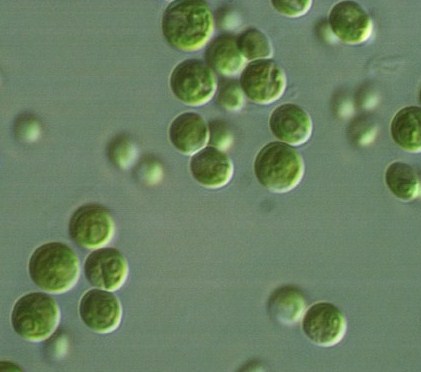
Chlorella and its characteristics

Chlorella is supposed to be a long-lived thing on our planet, it has existed for more than three billion years. Green alga is a numerous type of algae, and its evolution in water hasn’t led to formation of complex and large layers with tissue differentiation. Chlorella is a tiny spherical or pillow-like cell about 8 micrometers in size. Under normal conditions it quadruples in a day, and it has been the same for more than 3 billion years. It photosynthesizes energetically, consuming carbon dioxide and saturating water and air with oxygen and it becomes rich in nutrients absorbing them with its cell surface. During photosynthesis chlorella is able to use up to 12% of light energy, while ground plants can use only 1-2%. Provided there is enough light, chlorella destroys very actively pathogenic microorganisms. It concerns any micro algae which have only their bacteria-companions, it destroys all the others. But chlorella has no bacteria-companions (pathogens).
Processes taking place in waters algolised with the strain Chlorella vulgaris ИФР №С-111, are based on the unique properties of the strain, in other words it is based on its difference from all other known and used strains:
Planktonic properties – ability to float easily in water mass;
Homogeneous spread of cells in the surroundings;
no cell agglutination;
ability to create conditions preventing development of pathogenic microorganisms;
resistance to viruses, ricketsia and bacteria;
resistance to alpha-phages.
Getting into water, the strain Chlorella vulgaris ИФР №С-111 doesn’t fall out on the bottom and doesn’t stick to the highest green plants, and floats in the high water layers (40-160 cm), photosynthesizes actively and reproduces. During several days chlorella becomes a dominant microalgae in the pointed out water layer, saturating water with oxygen and eliminating extra carbon dioxide, organic and mineral chemicals. Meanwhile the whole pathogenic microflora is eliminated. As chlorella is the best fodder for zooplanckton, its number increases significantly. In case of water algolisation during spring time cyanobacteria don’t reproduce actively because chrorella manages to absorb biogenes necessary for the development of cyanobacteria. When water is infected with cyanobacteria introduction of our strain makes it possible to lyse accumulations of cyanobacteria and in the photosysnthesis process turn decomposition products into proteins, lipids and other nitrogen-containing organic compounds, included in chlorella structure.
The strain is protected by patent RF № 1751981 and is adopted for depositing in Plants Physiology Institute named after Timiryasev K.A. in Russian Science Academy.